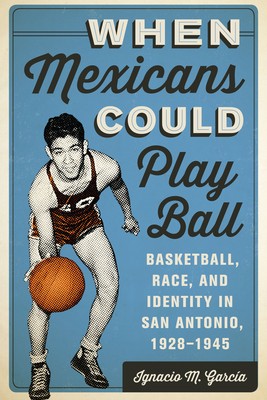
- We will send in 10–14 business days.
- Author: Ignacio M GarcÃa
- Publisher: University of Texas Press
- Year: 2014
- Pages: 292
- ISBN-10: 1477302123
- ISBN-13: 9781477302125
- Format: 15.2 x 22.9 x 1.7 cm, softcover
- Language: English
- SAVE -10% with code: EXTRA
Reviews
Description
Winner, Al Lowman Memorial Prize, Texas State Historical Association, 2014
In 1939, a team of short, scrappy kids from a vocational school established specifically for Mexican Americans became the high school basketball champions of San Antonio, Texas. Their win, and the ensuing riot it caused, took place against a backdrop of shifting and conflicted attitudes toward Mexican Americans and American nationalism in the WWII era. "Only when the Mexicans went from perennial runners-up to champs," GarcÃa writes, "did the emotions boil over."
The first sports book to look at Mexican American basketball specifically, When Mexicans Could Play Ball is also a revealing study of racism and cultural identity formation in Texas. Using personal interviews, newspaper articles, and game statistics to create a compelling narrative, as well as drawing on his experience as a sports writer, GarcÃa takes us into the world of San Antonio's Sidney Lanier High School basketball team, the Voks, which became a two-time state championship team under head coach William Carson "Nemo" Herrera. An alumnus of the school himself, GarcÃa investigates the school administrators' project to Americanize the students, Herrera's skillful coaching, and the team's rise to victory despite discrimination and violence from other teams and the world outside of the school. Ultimately, GarcÃa argues, through their participation and success in basketball at Lanier, the Voks players not only learned how to be American but also taught their white counterparts to question long-held assumptions about Mexican Americans.
EXTRA 10 % discount with code: EXTRA
The promotion ends in 19d.07:15:36
The discount code is valid when purchasing from 10 €. Discounts do not stack.
- Author: Ignacio M GarcÃa
- Publisher: University of Texas Press
- Year: 2014
- Pages: 292
- ISBN-10: 1477302123
- ISBN-13: 9781477302125
- Format: 15.2 x 22.9 x 1.7 cm, softcover
- Language: English English
Winner, Al Lowman Memorial Prize, Texas State Historical Association, 2014
In 1939, a team of short, scrappy kids from a vocational school established specifically for Mexican Americans became the high school basketball champions of San Antonio, Texas. Their win, and the ensuing riot it caused, took place against a backdrop of shifting and conflicted attitudes toward Mexican Americans and American nationalism in the WWII era. "Only when the Mexicans went from perennial runners-up to champs," GarcÃa writes, "did the emotions boil over."
The first sports book to look at Mexican American basketball specifically, When Mexicans Could Play Ball is also a revealing study of racism and cultural identity formation in Texas. Using personal interviews, newspaper articles, and game statistics to create a compelling narrative, as well as drawing on his experience as a sports writer, GarcÃa takes us into the world of San Antonio's Sidney Lanier High School basketball team, the Voks, which became a two-time state championship team under head coach William Carson "Nemo" Herrera. An alumnus of the school himself, GarcÃa investigates the school administrators' project to Americanize the students, Herrera's skillful coaching, and the team's rise to victory despite discrimination and violence from other teams and the world outside of the school. Ultimately, GarcÃa argues, through their participation and success in basketball at Lanier, the Voks players not only learned how to be American but also taught their white counterparts to question long-held assumptions about Mexican Americans.


Reviews